Neglected Microplastics and Their Risks in Rivers Throughout the Three Gorges Reservoir Area
Highlights
- Microplastics were ubiquitously detected across the Three Gorges Reservoir (TGR).
- The microplastic abundance in water and sediments was higher in the Yangtze River than in the tributaries of the TGR.
- Microplastic pollution in the TGR arises from the superposition of natural processes and human activities.
- The results reveal the neglected risks of microplastics in the river environment of the TGR.
- This work provides a critical basis for the prevention and control of microplastic pollution in this reservoir.
Abstract
1. Introduction
2. Materials and Methods
2.1. Study Area
2.2. Sample Collection
2.3. Extraction and Identification of Microplastics
2.4. Quality Assurance and Quality Control (QA/QC)
2.5. Risk Assessment
2.6. Statistical Analysis
3. Results and Discussions
3.1. Abundances of Microplastics in Water and Sediments
3.2. Composition Characteristics of Microplastics
3.3. Risks of Microplastics
4. Conclusions
Author Contributions
Funding
Institutional Review Board Statement
Informed Consent Statement
Data Availability Statement
Acknowledgments
Conflicts of Interest
References
- Cera, A.; Cesarini, G.; Scalici, M. Microplastics in freshwater: What is the news from the world? Diversity 2020, 12, 276. [Google Scholar] [CrossRef]
- Thompson, R.C.; Courtene-Jones, W.; Boucher, J.; Pahl, S.; Raubenheimer, K.; Koelmans, A.A. Twenty years of microplastic pollution research-what have we learned? Science 2024, 386, eadl2746. [Google Scholar] [CrossRef] [PubMed]
- Priyanka, R.; Govindarajulu, B. Microplastics accumulation and distribution in the surface water and sediment of the kosasthalaiyar river, Tamil Nadu, India. Water Air Soil Pollut. 2025, 236, 245. [Google Scholar] [CrossRef]
- Lebreton, L.C.M.; Van Der Zwet, J.; Damsteeg, J.W.; Slat, B.; Andrady, A.; Reisser, J. River plastic emissions to the world’s oceans. Nat. Commun. 2017, 8, 15611. [Google Scholar] [CrossRef]
- Zong, C.X.; Li, C.J.; Zhu, L.X.; Wang, X.H.; Wei, N.; Jiang, C.H.; Dong, X.R.; Jabeen, K.; Vo, T.T.; Li, D.J. Changes and transport of microplastics in the riverbed of the mainstream below the Three Gorges Dam of the Yangtze River. Gondwana Res. 2024, 128, 340–350. [Google Scholar] [CrossRef]
- Xu, D.Y.; Gao, B.; Wan, X.H.; Peng, W.Q.; Zhang, B.H. Influence of catastrophic flood on microplastics organization in surface water of the Three Gorges Reservoir, China. Water Res. 2022, 211, 118018. [Google Scholar] [CrossRef]
- Li, Y.; Ke, S.; Xu, D.Y.; Zhuo, H.H.; Liu, X.B.; Gao, B. Preferential deposition of buoyant small microplastics in surface sediments of the Three Gorges Reservoir, China: Insights from biomineralization. J. Hazard. Mater. 2024, 468, 133693. [Google Scholar] [CrossRef]
- Niu, X.R.; Wang, X.P.; Dong, H.K.; Ciren, N.; Zhang, H.F.; Chen, X.; Zhuoga, S.; Jia, X.H.; Xu, L.; Zhou, Y.Q. Microplastics in remote region of the world: Insights from the glacier of Geladandong, China. Appl. Geochem. 2024, 168, 106026. [Google Scholar] [CrossRef]
- Forgione, G.; Izzo, F.; Mercurio, M.; Cicchella, D.; Dini, L.; Giancane, G.; Paolucci, M. Microplastics pollution in freshwater fishes in the South of Italy: Characterization, distribution, and correlation with environmental pollutants. Sci. Total Environ. 2023, 864, 161032. [Google Scholar] [CrossRef]
- Wang, S.S.; Fang, L.J.; Wang, K.J.; Sun, X.B. Microplastics in the black-odor rivers in Harbin city, China: Abundance, characteristics, and ecological risk assessment. Gondwana Res. 2025, 142, 108–119. [Google Scholar] [CrossRef]
- Verma, M.; Singh, P.; Pradhan, V.; Dhanorkar, M. Spatial and seasonal variations in abundance, distribution characteristics, and sources of microplastics in surface water of Mula River in Pune, India. Environ. Pollut. 2025, 373, 126091. [Google Scholar] [CrossRef]
- Lin, H.T.; Schneider, F.; Aziz, M.A.; Wong, K.Y.; Arunachalam, K.D.; Praveena, S.M.; Sethupathi, S.; Chong, W.C.; Nafisyah, A.L.; Parthasarathy, P.; et al. Microplastics in Asian rivers: Geographical distribution, most detected types, and inconsistency in methodologies. Environ. Pollut. 2024, 349, 123985. [Google Scholar] [CrossRef]
- Nihei, Y.; Ota, H.; Tanaka, M.; Kataoka, T.; Kashiwada, J. Comparison of concentration, shape, and polymer composition between microplastics and mesoplastics in Japanese river waters. Water Res. 2024, 249, 120979. [Google Scholar] [CrossRef] [PubMed]
- Saad, D.; Ramaremisa, G.; Ndlovu, M.; Chimuka, L. Morphological and chemical characteristics of microplastics in surface water of the Vaal River, South Africa. Environ. Process. 2024, 11, 16. [Google Scholar] [CrossRef]
- Mutshekwa, T.; Munyai, L.F.; Mugwedi, L.; Cuthbert, R.N.; Dondofema, F.; Dalu, T. Seasonal occurrence of microplastics in sediment of two South African recreational reservoirs. Water Biol. Secur. 2023, 2, 100185. [Google Scholar] [CrossRef]
- Shen, J.C.; Gu, X.; Liu, R.; Feng, H.Y.; Li, D.P.; Liu, Y.; Jiang, X.F.; Qin, G.; An, S.Q.; Li, N.; et al. Damming has changed the migration process of microplastics and increased the pollution risk in the reservoirs in the Shaying River Basin. J. Hazard. Mater. 2023, 443, 130067. [Google Scholar] [CrossRef] [PubMed]
- Ullah, H.; Hafeez, S.; Mian, I.A.; Khan, A.A.; Khan, A.A.; Khan, B. Seasonal microplastic pollution in surface water and sediments of the Swat and Kabul rivers, Pakistan. J. Environ. Chem. Eng. 2025, 13, 117048. [Google Scholar] [CrossRef]
- Kim, L.; Kim, D.; Kim, S.A.; Kim, H.; Lee, T.Y.; An, Y.J. Are your shoes safe for the environment?—Toxicity screening of leachates from microplastic fragments of shoe soles using freshwater organisms. J. Hazard. Mater. 2022, 421, 126779. [Google Scholar] [CrossRef] [PubMed]
- Nath, J.; De, J.Y.T.; Sur, S.; Banerjee, P. Interaction of microbes with microplastics and nanoplastics in the agroecosystems—Impact on antimicrobial resistance. Pathogens 2023, 12, 888. [Google Scholar] [CrossRef]
- Tan, Y.P.; Dai, J.Y.; Xiao, S.W.; Tang, Z.Q.; Zhang, J.M.; Wu, S.Q.; Wu, X.F.; Deng, Y. Occurrence of microplastic pollution in rivers globally: Driving factors of distribution and ecological risk assessment. Sci. Total Environ. 2023, 904, 165979. [Google Scholar] [CrossRef]
- Rakib, M.R.J.; Hossain, M.B.; Kumar, R.; Ullah, M.A.; Al Nahian, S.; Rima, N.N.; Choudhury, T.R.; Liba, S.I.; Yu, J.; Khandaker, M.U.; et al. Spatial distribution and risk assessments due to the microplastics pollution in sediments of Karnaphuli River Estuary, Bangladesh. Sci. Rep. 2022, 12, 8581. [Google Scholar] [CrossRef]
- Shakik, A.; Brohomo, P.; Kabir, M.S.; Islam, M.S.; Mizan, M.H. Microplastic contamination in Rupsha River of Bangladesh and its impacts on fish species. Reg. Stud. Mar. Sci. 2025, 85, 104130. [Google Scholar] [CrossRef]
- Li, S.Y.; Wang, Y.L.; Liu, L.H.; Lai, H.W.; Zeng, X.C.; Chen, J.Y.; Liu, C.; Luo, Q.J. Temporal and spatial distribution of microplastics in a coastal region of the Pearl River Estuary, China. Water 2021, 13, 1618. [Google Scholar] [CrossRef]
- Min, R.; Ma, K.; Zhang, H.W.; Zhang, J.Q.; Yang, S.Y.; Zhou, T.H.; Zhang, G.Z. Distribution and risk assessment of microplastics in Liujiaxia Reservoir on the upper Yellow River. Chemosphere 2023, 320, 138031. [Google Scholar] [CrossRef]
- Gao, B.; Chen, Y.L.; Xu, D.Y.; Sun, K.; Xing, B.S. Substantial burial of terrestrial microplastics in the Three Gorges Reservoir, China. Commun. Earth Environ. 2023, 4, 32. [Google Scholar] [CrossRef]
- Li, W.; Zu, B.; Liu, Y.W.; Guo, J.C.; Li, J.W. Microplastics in sediment of the Three Gorges Reservoir: Abundance and characteristics under different environmental conditions. J. Oceanol. Limnol. 2024, 42, 101–112. [Google Scholar] [CrossRef]
- Yang, H.; Sun, F.H.; Liao, H.Q.; Guo, Y.D.; Pan, T.; Wu, F.C.; Giesy, J.P. Distribution, abundance, and risks posed by microplastics in surface waters of the Yangtze River Basin, China. Environ. Pollut. 2023, 333, 122086. [Google Scholar] [CrossRef] [PubMed]
- Sabri, N.A.A.; Razak, M.R.; Aris, A.Z. Fate of microplastics and emerging contaminants: Mechanisms of interactions, bioaccumulation and combined toxicity to aquatic organisms. Mar. Pollut. Bull. 2025, 214, 117822. [Google Scholar] [CrossRef]
- Zhang, S.H.; Jing, Z.; Yi, Y.J.; Wu, Y. The dynamic capacity calculation method and the flood control ability of the Three Gorges Reservoir. J. Hydrol. 2017, 555, 361–370. [Google Scholar] [CrossRef]
- Li, B.; Wan, H.; Cai, Y.Y.; Peng, J.P.; Li, B.W.; Jia, Q.P.; Yuan, X.; Wang, Y.Y.; Zhang, P.; Hong, B.; et al. Human activities affect the multidecadal microplastic deposition records in a subtropical urban lake, China. Sci. Total Environ. 2022, 820, 153187. [Google Scholar] [CrossRef]
- Tomlinson, D.L.; Wilson, J.G.; Harris, C.R.; Jeffrey, D.W. Problems in the assessment of heavy-metal levels in estuaries and the formation of a pollution index. Helgoländer Meeresunters. 1980, 33, 566–575. [Google Scholar] [CrossRef]
- Everaert, G.; De Rijcke, M.; Lonneville, B.; Janssen, C.R.; Backhaus, T.; Mees, J.; van Sebille, E.; Koelmans, A.A.; Catarino, A.I.; Vandegehuchte, M.B. Risks of floating microplastic in the global ocean. Environ. Pollut. 2020, 267, 115499. [Google Scholar] [CrossRef]
- Li, B.; Li, B.W.; Jia, Q.P.; Hong, B.; Xie, Y.L.; Yuan, X.; Peng, J.P.; Cai, Y.P.; Yang, Z.F. Source or sink role of an urban lake for microplastics from Guangdong-Hong Kong-Macao greater bay area, China. Environ. Res. 2023, 224, 115492. [Google Scholar] [CrossRef]
- Velez-Terreros, P.Y.; Romero-Estevez, D.; Yanez-Jacome, G.S. Microplastics in Ecuador: A review of environmental and health-risk assessment challenges. Heliyon 2024, 10, e23232. [Google Scholar] [CrossRef]
- Lithner, D.; Larsson, A.; Dave, G. Environmental and health hazard ranking and assessment of plastic polymers based on chemical composition. Sci. Total Environ. 2011, 409, 3309–3324. [Google Scholar] [CrossRef]
- Zulkernain, N.H.; Gani, P.; Chuan, N.C.; Uvarajan, T. Utilisation of plastic waste as aggregate in construction materials: A review. Constr. Build. Mater. 2021, 296, 123669. [Google Scholar] [CrossRef]
- Raubenheimer, K.; Urho, N. Rethinking global governance of plastics—The role of industry. Mar. Policy 2020, 113, 103802. [Google Scholar] [CrossRef]
- Zhao, W.L.; Huang, W.; Yin, M.C.; Huang, P.; Ding, Y.C.; Ni, X.; Xia, H.L.; Liu, H.J.; Wang, G.Q.; Zheng, H.W.; et al. Tributary inflows enhance the microplastic load in the estuary: A case from the Qiantang River. Mar. Pollut. Bull. 2020, 156, 111152. [Google Scholar] [CrossRef] [PubMed]
- Xu, Y.Y.; Chen, F.K.S.; Johnson, M.; Stanton, T.; He, J.; Jia, T.; Wang, J.; Wang, Z.L.; Yao, Y.T.; Yang, J.T.; et al. Microplastic pollution in Chinese urban rivers: The influence of urban factors. Resour. Conserv. Recycl. 2021, 173, 105686. [Google Scholar] [CrossRef]
- Lin, L.; Pan, X.; Zhang, S.; Li, D.W.; Zhai, W.L.; Wang, Z.; Tao, J.X.; Mi, C.Q.; Li, Q.Y.; Crittenden, J.C. Distribution and source of microplastics in China’s second largest reservoir—Danjiangkou Reservoir. J. Environ. Sci. 2021, 102, 74–84. [Google Scholar] [CrossRef] [PubMed]
- He, D.; Chen, X.J.; Zhao, W.; Zhu, Z.Q.; Qi, X.J.; Zhou, L.F.; Chen, W.; Wan, C.Y.; Li, D.W.; Zou, X.; et al. Microplastics contamination in the surface water of the Yangtze River from upstream to estuary based on different sampling methods. Environ. Res. 2021, 196, 110908. [Google Scholar] [CrossRef]
- Guo, Z.F.; Boeing, W.J.; Xu, Y.Y.; Borgomeo, E.; Mason, S.A.; Zhu, Y.G. Global meta-analysis of microplastic contamination in reservoirs with a novel framework. Water Res. 2021, 207, 117828. [Google Scholar] [CrossRef]
- Yang, R.L.; Han, X.; Wang, Y.T.; Liu, Y.X.; Sun, Q.Q.; Su, H.J.; Peng, S.C.; Lu, P.L.; Zhang, D.J.; Zhou, S.B. The Three Gorges Dam alters the spatial distribution and flux of microplastics in the Yangtze River. Environ. Res. 2025, 275, 121440. [Google Scholar] [CrossRef] [PubMed]
- He, Y.; Huang, Q.; Wang, Q.L.; Tang, M.F.; Lu, X.Y.; Cheng, F.; Xiao, G.S. Seasonal pollution and surface characteristics of microplastics in surface water in the Wanzhou section of the Three Gorges Reservoir, China. Environ. Sci. Pollut. Res. 2023, 30, 67854–67864. [Google Scholar] [CrossRef]
- Han, N.P.; Ao, H.Y.; Mai, Z.; Zhao, Q.C.; Wu, C.X. Characteristics of (micro) plastic transport in the upper reaches of the Yangtze River. Sci. Total Environ. 2023, 855, 158887. [Google Scholar] [CrossRef]
- Harpah, N.; Rizki, A.; Ageng, P.; Adawiyah, R.; Perdana, Z.; Suryati, I.; Leonardo, R.; Husin, A.; Faisal, M. Microplastic as a pollution in Babura River Medan: A study Case. J. Phys. Conf. Ser. 2023, 2421, 012019. [Google Scholar] [CrossRef]
- Napper, I.E.; Baroth, A.; Barrett, A.C.; Bhola, S.; Chowdhury, G.W.; Davies, B.F.R.; Duncan, E.M.; Kumai, S.; Nelms, S.E.; Niloy, M.N.H.; et al. The abundance and characteristics of microplastics in surface water in the transboundary Ganges River. Environ. Pollut. 2021, 274, 116348. [Google Scholar] [CrossRef]
- Xu, Q.J.; Xing, R.L.; Sun, M.D.; Gao, Y.Y.; An, L.H. Microplastics in sediments from an interconnected river—Estuary region. Sci. Total Environ. 2020, 729, 139025. [Google Scholar] [CrossRef]
- Zhao, X.L.; Liu, Z.H.; Cai, L.; Han, J.Q. Occurrence and distribution of microplastics in surface sediments of a typical river with a highly eroded catchment, a case of the Yan River, a tributary of the Yellow River. Sci. Total Environ. 2023, 863, 160932. [Google Scholar] [CrossRef] [PubMed]
- Li, Z.G.; Xu, B.; Zhang, R.H.; Wang, F.; Li, L.Y.; Wang, K.L.; Zhang, R.Q.; Jing, X.X.; Liu, Y.; Chen, P. Effects of land use on soil microplastic distribution adjacent to Danjiangkou reservoir, China. Chemosphere 2023, 338, 139389. [Google Scholar] [CrossRef]
- He, B.B.; Goonetilleke, A.; Ayoko, G.A.; Rintoul, L. Abundance, distribution patterns, and identification of microplastics in Brisbane River sediments, Australia. Sci. Total Environ. 2020, 700, 134467. [Google Scholar] [CrossRef]
- Widigdo, B.; Imran, Z.; Wulandari, D.Y.; Marliana, A. Spatial distribution of microplastic in sediment of the Citanduy River, West Java, Indonesia. IOP Conf. Ser. Earth Environ. Sci. 2021, 744, 012098. [Google Scholar] [CrossRef]
- Kole, P.J.; Lohr, A.J.; Van Belleghem, F.G.; Ragas, A.M.J. Wear and tear of tyres: A stealthy source of microplastics in the environment. Int. J. Environ. Res. Public Health 2017, 14, 1265. [Google Scholar] [CrossRef]
- Liu, P.; Zhan, X.; Wu, X.W.; Li, J.L.; Wang, H.Y.; Gao, S.X. Effect of weathering on environmental behavior of microplastics: Properties, sorption and potential risks. Chemosphere 2020, 242, 125193. [Google Scholar] [CrossRef] [PubMed]
- Liu, Y.X.; Cao, W.G.; Hu, Y.; Zhang, J.; Shen, W.B. Horizontal and vertical distribution of microplastics in dam reservoir after impoundment. Sci. Total Environ. 2022, 832, 154962. [Google Scholar] [CrossRef] [PubMed]
- Zhang, K.; Shi, H.H.; Peng, J.P.; Wang, Y.H.; Xiong, X.; Wu, C.X.; Lam, P.K.S. Microplastic pollution in China’s inland water systems: A review of findings, methods, characteristics, effects, and management. Sci. Total Environ. 2018, 630, 1641–1653. [Google Scholar] [CrossRef] [PubMed]
- Besseling, E.; Quik, J.T.K.; Sun, M.; Koelmans, A.A. Fate of nano-and microplastic in freshwater systems: A modeling study. Environ. Pollut. 2017, 220, 540–548. [Google Scholar] [CrossRef]
- Da Silva, V.H.; Murphy, F.; Amigo, J.M.; Stedmon, C.; Strand, J. Classification and quantification of microplastics (<100 μm) using a focal plane array—Fourier transform infrared imaging system and machine learning. Anal. Chem. 2020, 92, 13724–13733. [Google Scholar]
- Chand, R.; Iordachescu, L.; Backbom, F.; Andreasson, A.; Bertholds, C.; Pollack, E.; Molazadeh, M.; Lorenz, C.; Nielsen, A.H.; Vollertsen, J. Treating wastewater for microplastics to a level on par with nearby marine waters. Water Res. 2024, 256, 121647. [Google Scholar] [CrossRef]
- Jaiswal, P.K.; Vijayan, V.; Kumar, S.; Kumar, R.; Singh, R. Seasonal distribution of microplastics and associated ecological risks in a semi-arid freshwater ecosystem in India. Environ. Pollut. 2025, 376, 126430. [Google Scholar] [CrossRef]
- Gerassimidou, S.; Geueke, B.; Groh, K.J.; Muncke, J.; Hahladakis, J.N.; Martin, O.; Iacovidou, E. Unpacking the complexity of the polyethylene food contact articles value chain: A chemicals perspective. J. Hazard. Mater. 2023, 454, 131422. [Google Scholar] [CrossRef]
- Zhang, W.C.; Shen, J.; Guo, X.G.; Wang, K.; Jia, J.; Zhao, J.T.; Zhang, J.S. Comprehensive investigation into the impact of degradation of recycled polyethylene and recycled polypropylene on the thermo-mechanical characteristics and thermal stability of blends. Molecules 2024, 29, 4499. [Google Scholar] [CrossRef]
- Kabir, A.H.M.E.; Sekine, M.; Imai, T.; Yamamoto, K.; Kanno, A.; Higuchi, T. Microplastics in the sediments of small-scale Japanese rivers: Abundance and distribution, characterization, sources-to-sink, and ecological risks. Sci. Total Environ. 2021, 812, 152590. [Google Scholar] [CrossRef] [PubMed]
- Lin, L.; Zuo, L.Z.; Peng, J.P.; Cai, L.Q.; Fok, L.; Yan, Y.; Li, H.X.; Xu, X.R. Occurrence and distribution of microplastics in an urban river: A case study in the Pearl River along Guangzhou City, China. Sci. Total Environ. 2018, 644, 375–381. [Google Scholar] [CrossRef] [PubMed]
- Zhu, H.; Bing, H.J.; Wu, Y.H.; Zhou, J.; Sun, H.Y.; Wang, J.P.; Wang, X.X. The spatial and vertical distribution of heavy metal contamination in sediments of the Three Gorges Reservoir determined by anti-seasonal flow regulation. Sci. Total Environ. 2019, 664, 79–88. [Google Scholar] [CrossRef]
- Li, C.W.; Xu, Y.; Song, W.W. Pollution characteristics and risk assessment of typical antibiotics and persistent organic pollutants in reservoir water sources. Water 2023, 15, 259. [Google Scholar] [CrossRef]
- Huang, W.; Song, B.A.; Liang, J.; Niu, Q.Y.; Zeng, G.M.; Shen, M.C.; Deng, J.Q.; Luo, Y.A.; Wen, X.F.; Zhang, Y.F. Microplastics and associated contaminants in the aquatic environment: A review on their ecotoxicological effects, trophic transfer, and potential impacts to human health. J. Hazard. Mater. 2021, 405, 124187. [Google Scholar] [CrossRef]
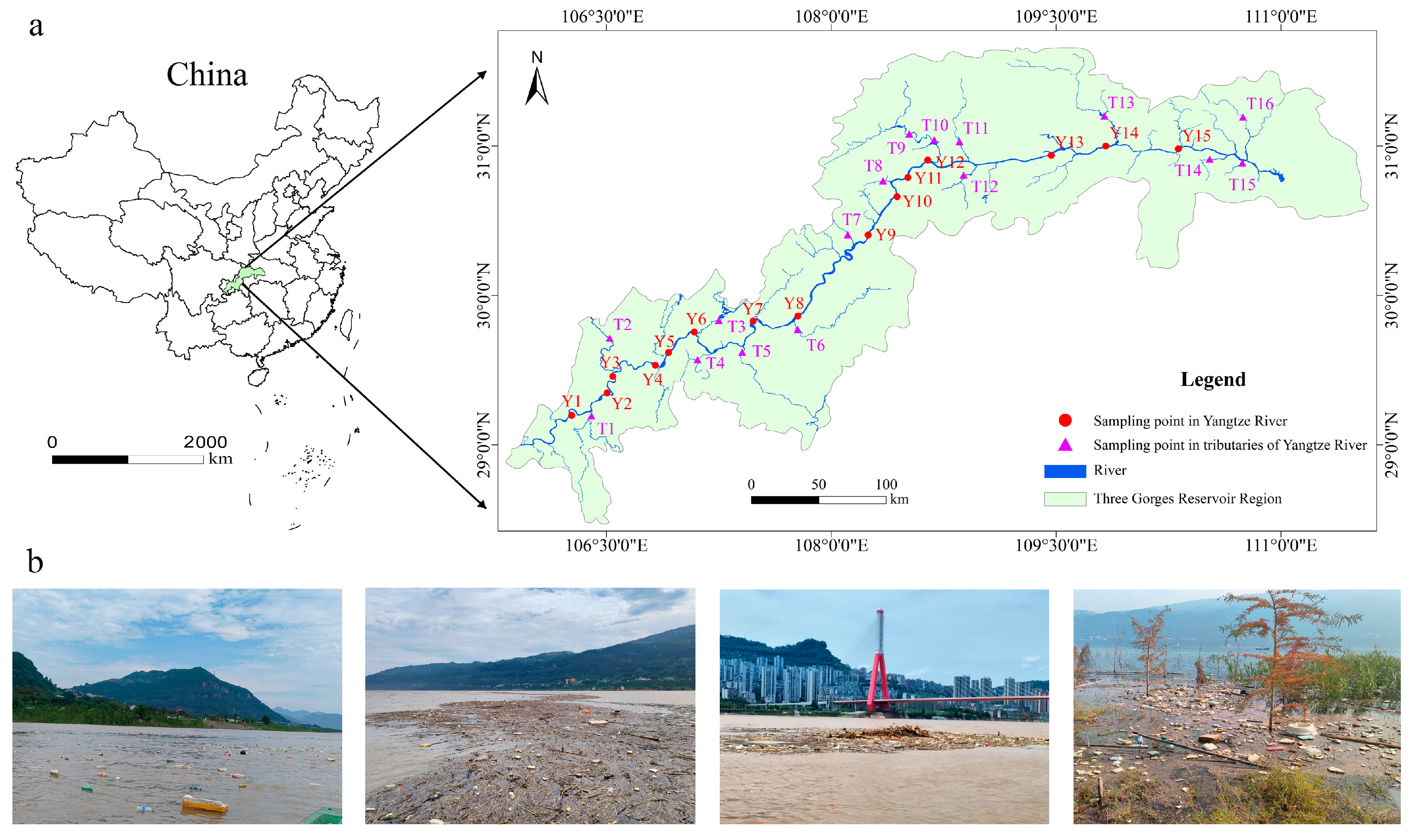
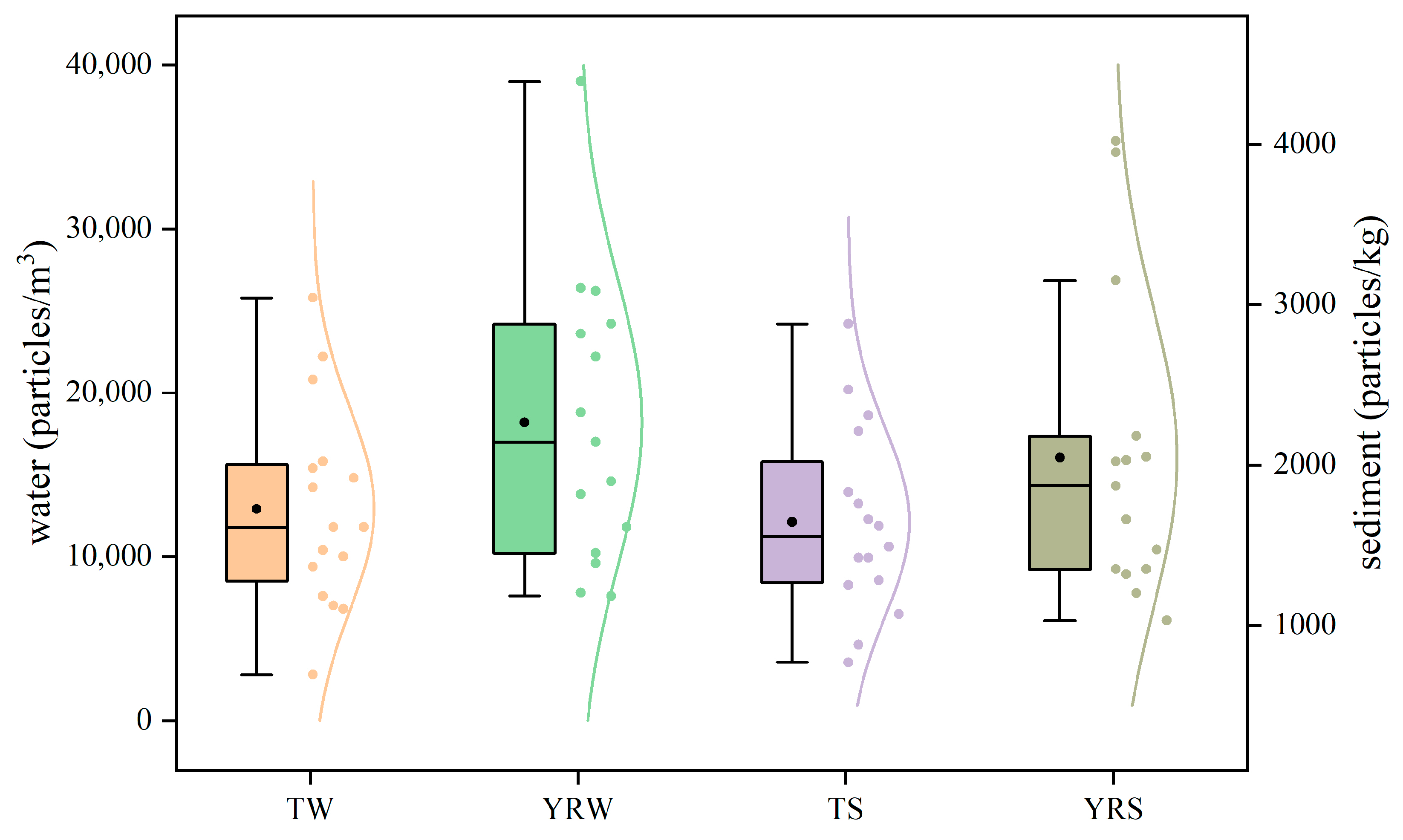

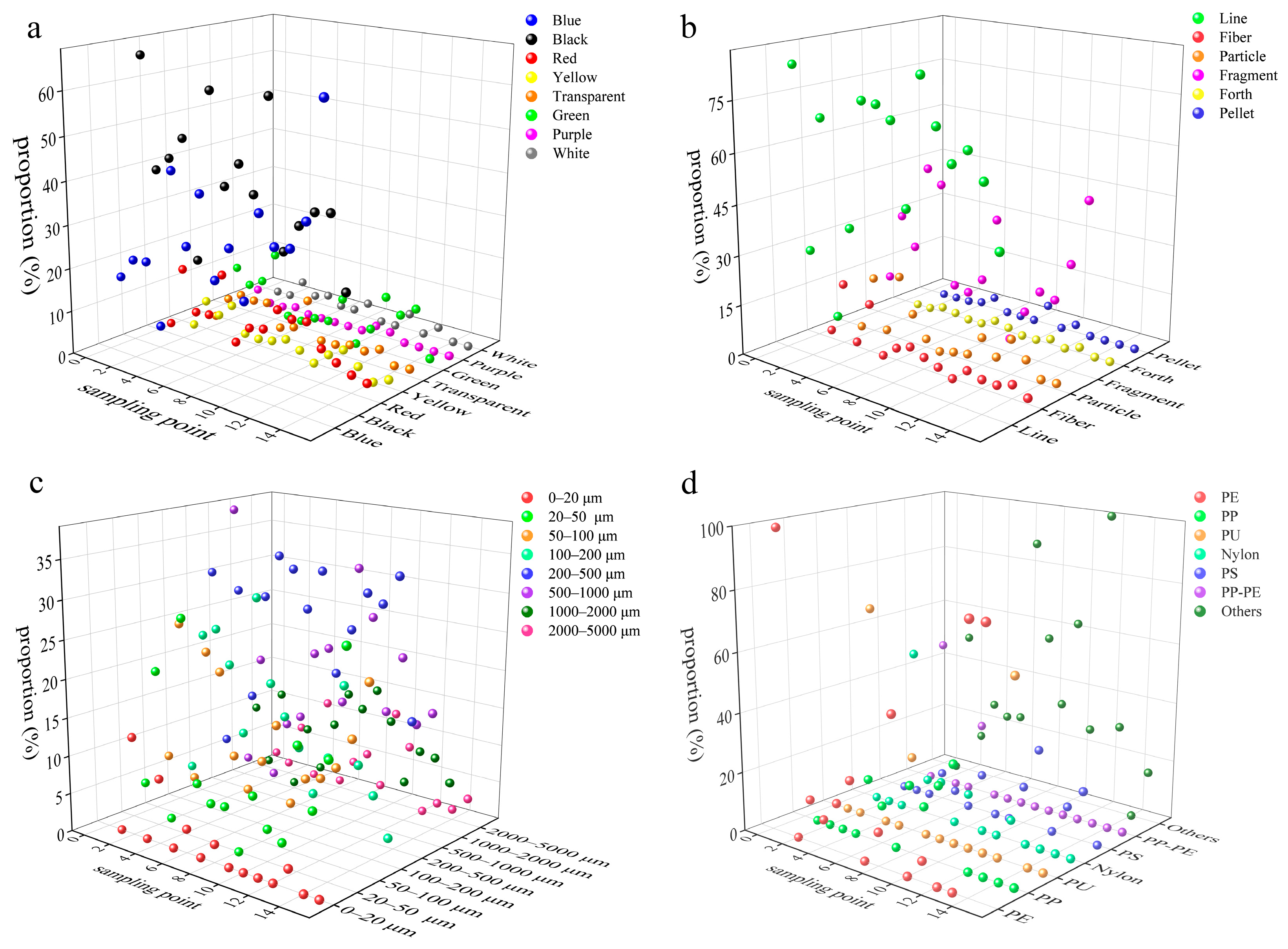
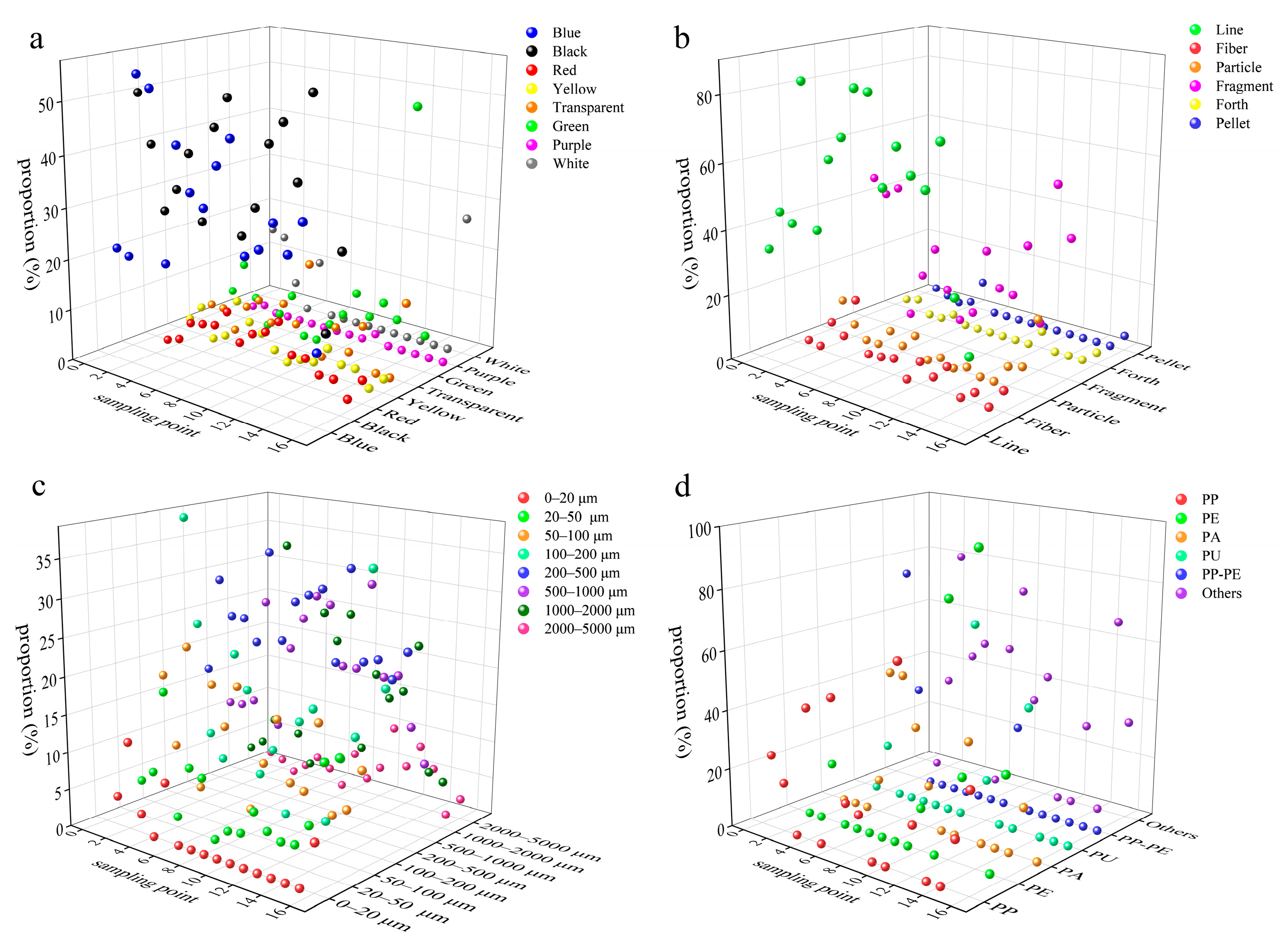
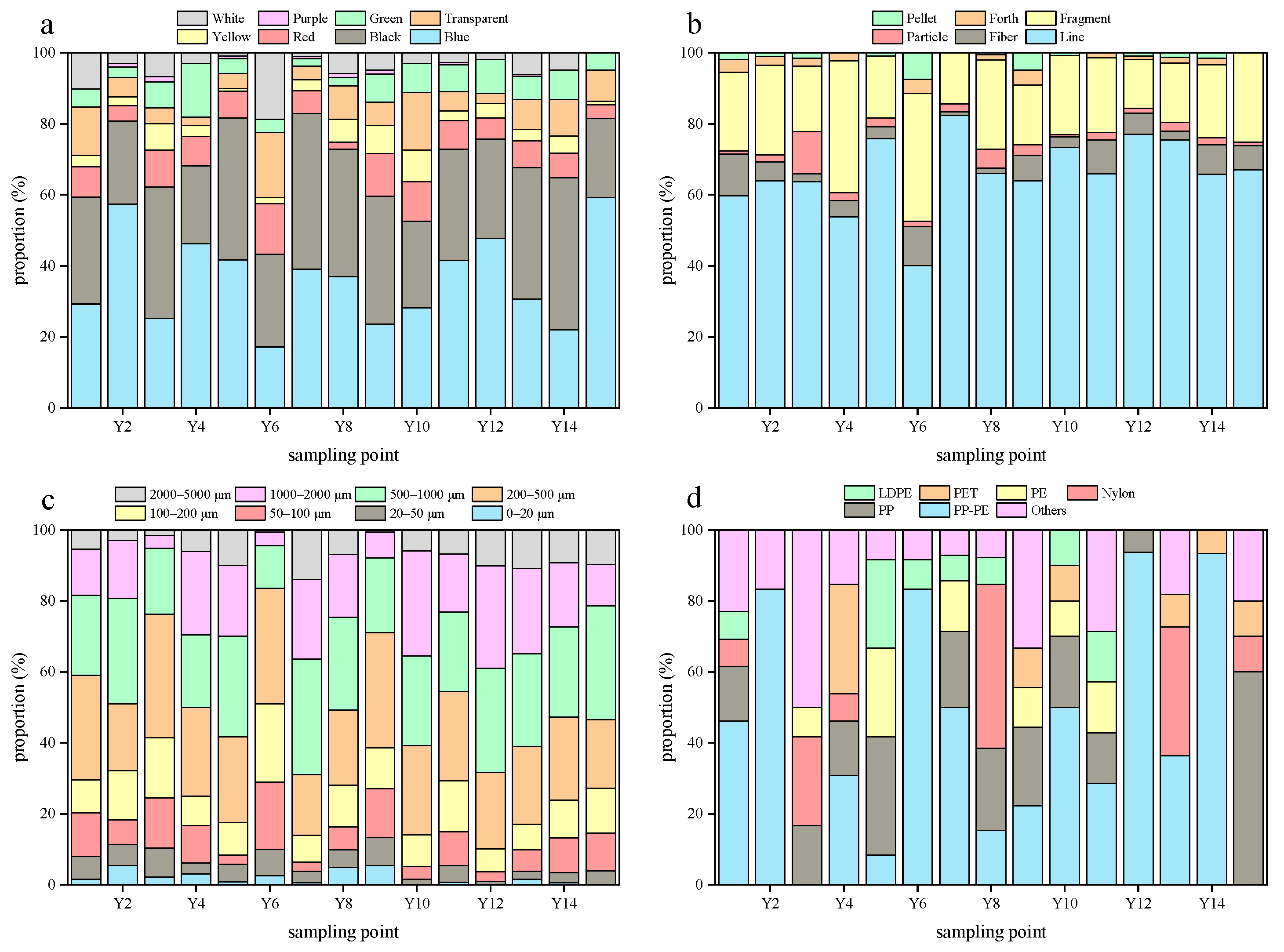


| Grade | I | II | III | IV | V |
|---|---|---|---|---|---|
| < 10 | 10 ≤ < 20 | 20 ≤ < 30 | 30 ≤ < 40 | ≥ 40 | |
| RI | RI < 20 | 20 ≤ RI < 40 | 40 ≤ RI < 60 | 60 ≤ RI < 80 | RI ≥ 80 |
| Risk level | low | moderate | high | severe | extremely |
| Area | Unit | Abundance | Mean Abundance | Reference | |
|---|---|---|---|---|---|
| Water | TGR | particles/m3 | 2800~39,000 | 15,465 | This study |
| TGR | items/m3 | / | 2614 ± 297 | [41] | |
| TGR | items/m3 | / | 4895 ± 3670 | [43] | |
| TGR | particles/m3 | / | 6214 ± 5394 | [25] | |
| Danjiangkou Reservoir (China) | particles/m3 | 530~24,798 | 7205 | [40] | |
| Liujiaxia Reservoir (China) | particles/m3 | 4.48 × 106~12.09 × 106 | / | [24] | |
| Babura River (Indonesia) | particles/m3 | 6.8 × 104~13.2 × 104 | / | [46] | |
| River Ganga (India) | particles/m3 | 51 ± 7 | 26 ± 4 | [47] | |
| Sediments | TGR | particles/kg | 770~4020 | 1838 | This study |
| TGR | items/kg | / | 286 ± 229 | [43] | |
| Shuangtaizi River (China) | n/kg | 67~300 | 170 ± 96 | [48] | |
| Daliao River (China) | n/kg | 100~476 | 237 ± 129 | [48] | |
| Yan River (China) | n/kg | 208~686.67 | 444.95 | [49] | |
| Danjiangkou Reservoir (China) | Items/kg | / | 3989 | [50] | |
| Liujiaxia Reservoir (China) | Item/kg | 447.27~1543.80 | / | [24] | |
| Brishbane River (Australia) | Items/kg | 10~520 | / | [51] | |
| Citanduy River (Indonesia) | n/kg | 18,190~70,405 | / | [52] |
| Microplastic Polymer Type | Abbreviation | YRW (%) | TW (%) | YRS (%) | TS (%) |
|---|---|---|---|---|---|
| Polyethylene | PE | 19.68 | 17.02 | 5.20 | 4.89 |
| Polypropylene | PP | 12.60 | 18.09 | 16.18 | 10.33 |
| Polyurethane | PU | 10.24 | 9.57 | 1.73 | 4.89 |
| Nylon | Nylon | 9.45 | 4.26 | 9.25 | 5.44 |
| Polystyrene | PS | 7.87 | 2.13 | 4.05 | 1.09 |
| Polypropylene–polyethylene copolymer | PP-PE | 6.30 | 7.45 | 44.51 | 53.8 |
| Polyamide | PA | 5.51 | 12.76 | 1.16 | 1.63 |
| Polyethylene terephthalate | PET | 3.93 | 1.06 | 5.20 | 1.09 |
| Phenol resin | PR | 3.15 | 5.32 | / | / |
| polybutadiene | PB | 1.57 | 2.13 | 1.16 | / |
| Polyolefin | PO | 0.79 | 1.06 | 1.16 | 1.63 |
| Polyester | PES | 0.79 | 1.06 | / | / |
| Low-density polyethylene | LDPE | 0.79 | / | 5.20 | 2.17 |
| Polymethacrylate–polystyrene copolymer | PAM-PS | 0.79 | / | 1.73 | 2.17 |
| Others | Others | 16.54 | 18.09 | 3.47 | 10.87 |
Disclaimer/Publisher’s Note: The statements, opinions and data contained in all publications are solely those of the individual author(s) and contributor(s) and not of MDPI and/or the editor(s). MDPI and/or the editor(s) disclaim responsibility for any injury to people or property resulting from any ideas, methods, instructions or products referred to in the content. |
© 2025 by the authors. Licensee MDPI, Basel, Switzerland. This article is an open access article distributed under the terms and conditions of the Creative Commons Attribution (CC BY) license (https://creativecommons.org/licenses/by/4.0/).
Share and Cite
Xie, J.-Y.; Li, B.; Jia, Q.-P.; Li, X.; Zhao, Q.; Fan, P.-D.; Wang, C.-Q.; Zhang, L.-Y. Neglected Microplastics and Their Risks in Rivers Throughout the Three Gorges Reservoir Area. Toxics 2025, 13, 781. https://doi.org/10.3390/toxics13090781
Xie J-Y, Li B, Jia Q-P, Li X, Zhao Q, Fan P-D, Wang C-Q, Zhang L-Y. Neglected Microplastics and Their Risks in Rivers Throughout the Three Gorges Reservoir Area. Toxics. 2025; 13(9):781. https://doi.org/10.3390/toxics13090781
Chicago/Turabian StyleXie, Jian-Yun, Bo Li, Qun-Po Jia, Xiao Li, Qin Zhao, Pei-Dang Fan, Chang-Qing Wang, and Liu-Yi Zhang. 2025. "Neglected Microplastics and Their Risks in Rivers Throughout the Three Gorges Reservoir Area" Toxics 13, no. 9: 781. https://doi.org/10.3390/toxics13090781
APA StyleXie, J.-Y., Li, B., Jia, Q.-P., Li, X., Zhao, Q., Fan, P.-D., Wang, C.-Q., & Zhang, L.-Y. (2025). Neglected Microplastics and Their Risks in Rivers Throughout the Three Gorges Reservoir Area. Toxics, 13(9), 781. https://doi.org/10.3390/toxics13090781






